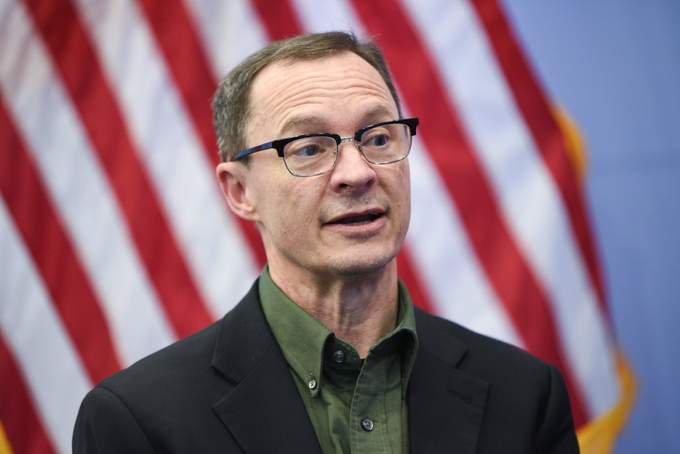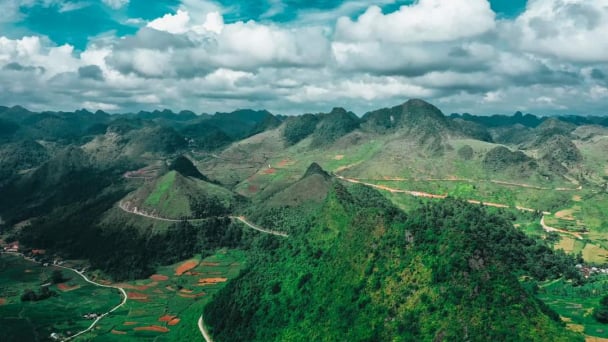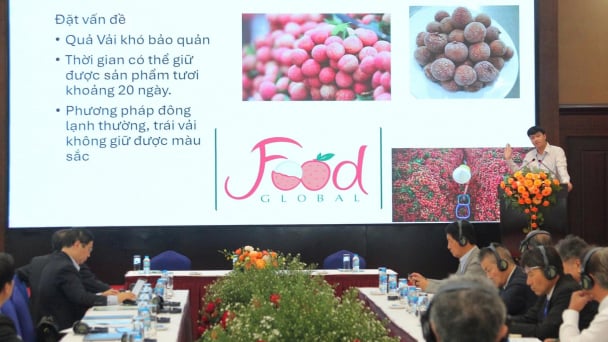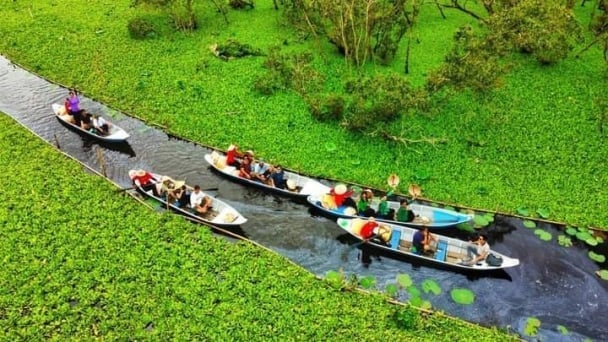June 16, 2025 | 17:23 GMT +7
June 16, 2025 | 17:23 GMT +7
Hotline: 0913.378.918
June 16, 2025 | 17:23 GMT +7
Hotline: 0913.378.918

Ralph Bean, US Agricultural Counselor to Vietnam.
As you know, Vietnam is transitioning from agricultural production to an agricultural economy. What's your comment on this?
This is a transformation that is common to many countries. It essentially involves the transition from people being born into agriculture – and learning agricultural methods from their family, parents, and community – to professional farming, where they utilize a lot more formal education, more advanced techniques and equipment. It's not all about technology, a lot of it is about knowing the alternatives and managing a farm as a business. I call this the professionalization of agriculture. It is a transition that every country has to go through if it really wants to modernize its economy and meet its food security needs. The fact that the Vietnamese government is thinking in these terms and targeting this specifically is a very good sign. They have the right focus and they're thinking about it the right way. This is about turning farming into a profession rather than something that you're simply born into, and will lead to development of the distribution chain, improve crop yields, and reduce food loss and spoilage. Vietnamese agriculture will be able to diversify and provide a wider variety of products for Vietnamese consumers, as well as free up land and labor resources to support a broader economy that transitions into services and manufacturing. It's part of Vietnam's transformation into a top-tier economy.
Vietnam has been making efforts to meet its climate commitments and transition into greener forms of agricultural production. In your opinion, how can Vietnam and the United States work together as Vietnam strives to achieve this goal?
First, I want to commend the Vietnamese government for its commitments. The Ministry of Agriculture and Rural Development in particular, is very aggressive in the commitments that it has made to reduce greenhouse gas emissions in agriculture and adapt to the changes caused by climate change. The collaboration that you talked about is already happening as we speak. We have a project to work with Vietnam to develop software that will help Vietnamese farmers adjust feed rations for animals, beginning with cattle, to reduce the amount of greenhouse gas emissions in livestock production, simply by changing the diet of the animals. We're looking at expanding this program to additional species and to additional practices, so it can become broadly applicable and useful as a tool for animal husbandry in Vietnam to reduce greenhouse gas emissions.
We're working with the Vietnamese government on biotechnology, which is a powerful tool for introducing plant varieties that can reduce greenhouse gas emissions and adapt to climate change. We have funded a Vietnamese researcher to travel to the United States to look into the use of gene editing to create drought-tolerant soybeans. We also support Vietnam for participating in a number of exchanges related to biotechnology. Gene editing is an extraordinarily powerful tool that I think Vietnam will find very useful in the future. Beyond this, along with other parts of the U.S. Embassy, we have set up a Climate Change Working Group with the Ministry of Agriculture and Rural Development. Their engagement has been fantastic. We really appreciate the very positive and energetic approach that the ministry has taken to this group and we have very bright hopes for the future for this group.
In recent years, the United States as being the largest market for videos, every kind of product, however, the types of goods approved by the US market are still immediate. What do you think about the prospects of expanding this list, especially for other kinds of Vietnamese products?
As you pointed out, the United States has become the largest market for Vietnamese agriculture, and Vietnam is now the eighth largest market for the United States to export agriculture. I think this is a very strong relationship. However, when it comes to things like fresh fruit and vegetables, there is a regulatory and scientific process in place, and at present each side works on one product at a time. Right now the US provides access to seven types of fresh fruit from Vietnam. We just granted pomelos a couple of weeks ago. And Vietnam grants access for six US products. These are cherries, apples, pears, grapes, blueberries, and oranges. Right now Vietnam is in the process of working on grapefruit. Now that we've approved pomelos, we will move on to the next product. So it proceeds in order. And the choice of which product we work on is made by the Vietnamese government. They tell us what we they want us to work on and then that process proceeds. We would love for it to go faster. But this is a scientific process where the two sides exchange back and forth several times to make sure that any pests or disease risks are taken care of before the products start to move. And like I said, the process is exactly the same for the US to apply for access to the Vietnamese market as it is the other way. So this is really up to the regulators.
Can you please share with us your thoughts on the training and investment collaboration between the two countries? What should be done to further promote agricultural trade between the two countries?
Regarding training, we have two programs, Cochrane and Borlaug. I mentioned one of the Cochrane fellows who went to the United States to study gene editing in soybeans. We have another one that we’re working on right now, which is maximum residue limits for chemicals in food. It’s a great program, and we expect to continue and hopefully even expand. Vietnam was recently named as one of the four countries identified under a program called Global Fertilizer Challenge. It’s a solid program to help Vietnam get better use of fertilizer. This does two things: it reduces farmers costs because it helps them identify the exact right times and ways to use fertilizer, and it cuts pollution into the water from excess fertilizer. So you're saving money and improving the environment. And there are various other training programs beyond Cochran and Borlaug that we are looking into utilizing in Vietnam.
For the United States, investment is typically done by the private sector. My office is more than happy to – and we frequently do – introduce U.S. companies to Vietnam, briefing them on conditions and opportunities in Vietnam. But it's up to them whether they want to invest in Vietnam.
Trade is developing extremely well. Vietnam is our eighth largest market, and I think the more companies come here, do business here, the more they're going to see those opportunities, the more comfortable they're going to become doing business. From a business standpoint the main concern is risk, and what reduces risk is knowledge. Knowing the place, knowing what's likely to happen, what the risks are, they take conscious risks. I think continuing to promote trade and continuing to collaborate will help create the conditions for those kinds of investment. I work on a daily basis to help introduce U.S. companies to Vietnam, help them understand and gain more confidence in the market. We think the potential here is tremendous, and likewise in the other direction. For the most part, it's a matter of continuing to do what we're doing to help people learn about and understand the market.
You have just started your term of office in Vietnam. Do you set any specific targets or objectives during your term in Vietnam?
My predecessor Robert Hanson did an extremely good job and the programs that he set up here are excellent. They're exactly what I would have done in his place. I do have certain projects that I hope I can follow up, but a lot of it is between me and my agency in Washington and working out what they're willing to support. I think projects, especially on supply chain, have a lot of potential here. And one of my favorite areas to work in supply chain is on “cold chain.” I think cold chain distribution, and distribution in general, is something that we can really work well with Vietnam on. It's something that helps Vietnamese farmers. When you have good cold chain, your fruits and vegetables, and especially meat and fisheries products, preserve their quality much better getting to market and fetch a better price. It reduces spoilage and waste, which also plays to the whole climate change issue. Because when you're adapting to climate change, you also need to get the most out of the products that your farmers are working hard to produce. Our exporters are very concerned about maintaining the quality of their product as it comes to market. No producer of meat or poultry in the United States wants to have a group of people get sick from their products because they were mishandled at some point. So we’re building a good, solid cold chain and getting those standards into place. That's where my agency does particularly well and I would really love to work on that here.
Thank you very much!

(VAN) The UNESCO Global Geopark revalidation of Non nuoc Cao Bang and the transition to a two-tier administrative model are presently undergoing a pivotal moment in Cao Bang, the northernmost province of Vietnam.
/2025/06/13/5330-2-004539_953.jpg)
(VAN) Changing policy mindset and removing investment barriers are urgent requirements to open up new development space for enterprises in the agricultural sector.

(VAN) The areas include the restoration of five million hectares of marine ecosystems.

(VAN) Dr. Le Van Nguyen, Director of the Institute of E-Commerce Management (ECM), emphasizes the potential for green development through the cultivation of fruit trees, particularly in provinces such as Son La.

(VAN) VAAS and numerous Vietnamese enterprises have signed cooperation agreements with Japanese partners to promote agricultural technology and trade connectivity.
/2025/05/29/5625-12-214801_567.jpg)
(VAN) Provincial mergers in the Mekong Delta promise to streamline administration, expand inter-provincial raw material areas, and foster close linkages in agricultural value chains, benefiting both businesses and cooperatives.

(VAN) Merging Mekong Delta provinces contributes to the expansion of agricultural raw material areas, addressing previous constraints caused by provincial boundaries. Additionally, this expansion will reduce costs and strengthen linkages between businesses, cooperatives, and farmers.